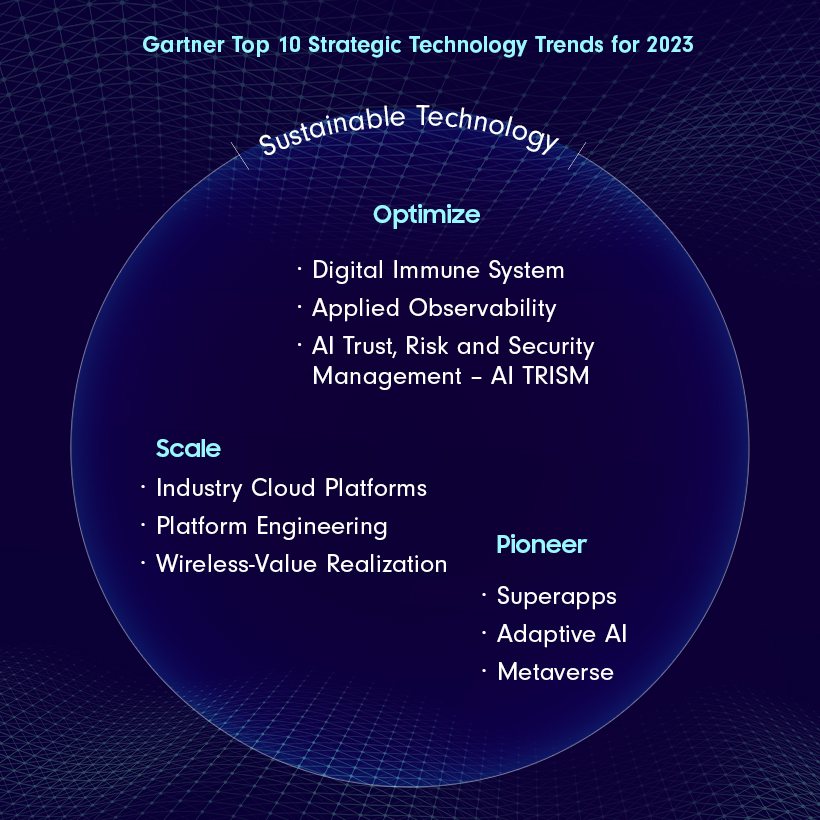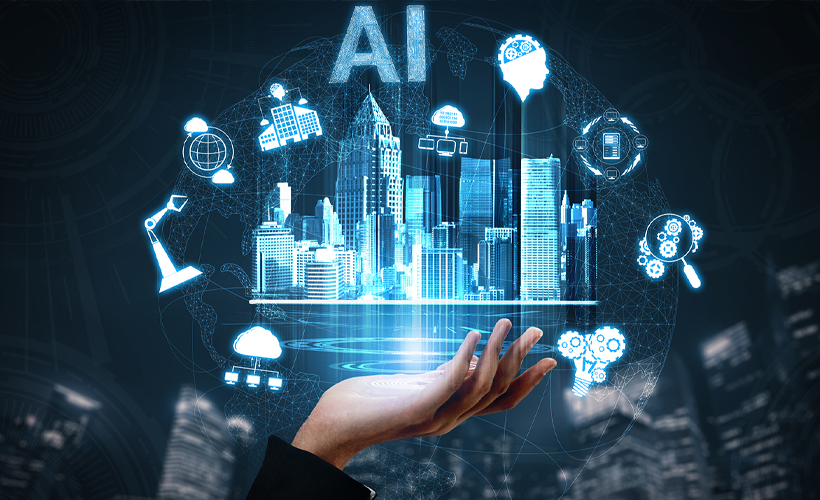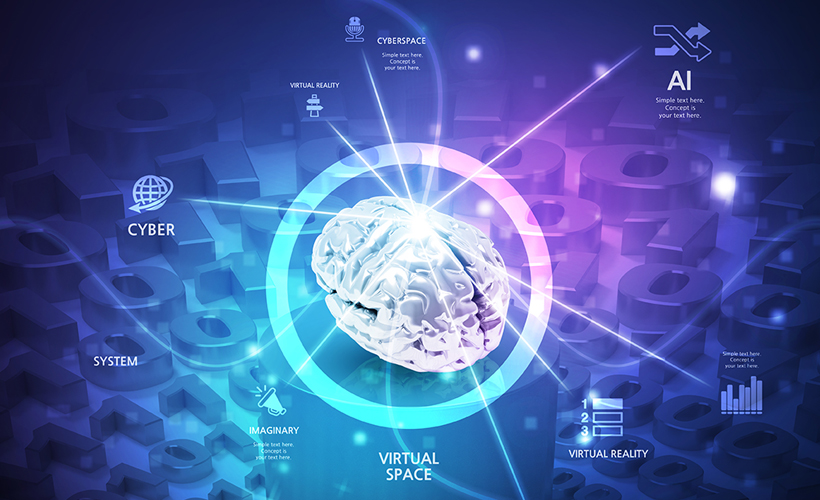
IT research and advisory service firm Gartner announced its ‘Top 10 Strategic Technology Trends for 2023’ at its symposium held in October 2022. Gartner has been publishing key strategic technology trends every year to analyze the latest trends in IT technology development. This year, the firm classified the strategic technology trends for 2023 under three themes: Optimize, Scale, and Pioneer. Find out more about the top 10 technologies ed by Gartner.

# Theme 1: Optimize
Digital Immune System

Digital immunity refers to optimizing and automating IT system operations based on data to automatically resolve unexpected issues such as system errors. In a recent incident in Korea, a key domestic messenger app service was down due to a fire at its data center, demonstrating the dangerous consequences of a vulnerable digital system. In the past, technology was utilized to support a company's business operations, but today, it is at the heart of generating profits for the company. This means that IT errors and incidents can be a massive blow to the company's finances. Building a digital immune system can reduce such unexpected errors or downtime, contributing to a boost in the profits of a business.
Applied Observability

Many companies struggle to manage massive amounts of data with increasingly complex and evolving systems. Observable data refers to objective indicators that appear when a user takes action within a system, such as logs, API calls, downloads, and file transfers. Integrated application of such indicators can enable real-time analysis of any issue. In order to enhance observability, an AI algorithm that can identify data must be designed within the system to swiftly detect and diagnose a problem. In other words, an active and preemptive response system is required, which will reduce latency for response in the event of any issue, ultimately contributing to optimized business operations.
AI Trust, Risk and Security Management – AI TRISM

As the bias and errors of AI lead to a plethora of societal issues, Gartner argues that AI TRiSM – which stands for Trust, Risk, and Security Management – is required for AI to improve further, and these elements must be prioritized. The rapid development of AI has resulted in a series of problems, and comprehensive management has become essential to address such issues. Even the leading companies that utilize AI, use only 50% of the AI models for their production, which is attributed to a lack of trust in the data and issues with security and privacy. In order to address such matters, Gartner advises that efforts must be made to continuously develop AI learning models that can manage reliability and data protection.
# Theme 2: Scale
Industry Cloud Platforms

Gartner forecasts that more than 50% of companies will use industry cloud platforms by 2027 and that the cloud network will serve as a key business asset. Integrated cloud platforms, which include industry cloud as well as various assets required for business, are being vertically expanded. Vertical expansion means the strengthening of cloud platforms that target specific industries with a set of specialized functionalities. Microsoft and Amazon Web Services (AWS), which have been focusing on the industry cloud, are defining industry-specific requirements and packaging various general services so that users can manage digital data more efficiently. Industry cloud platforms are particularly showing strong growth in medicine, manufacturing, supply chain, agriculture, and finance and are projected to play a greater role in a wider variety of industries.
Platform Engineering

Platform engineering refers to building and operating internal developer platforms aimed at software delivery and lifecycle management. The goal of platform engineering is to optimize the developer experience and increase the productivity of end users. Platform engineering helps reduce the number of difficulties faced by developers by providing a set of functionalities and processes that can be easily utilized by developers and end users. In line with this, Gartner suggested a solution for platform engineering, it should be structured in a way that is conducive to use by developers through IDE*, CI/CD*, and monitoring devices.
*IDE(Integrated Development Environment)
*CI/CD(Continuous Integration/Continuous Delivery, Deployment)
*IDE(Integrated Development Environment): A software application interface under an Integrated development environment for efficient software development
*CI/CD(Continuous Integration/Continuous Delivery, Deployment): A method of offering applications at an increased frequency by automating the application development phase.
Wireless-Value Realization

Wireless communication technology is expected to expand even further in line with the advances in mobile services, as well as other developments in the broader environment. Gartner forecasts that 60% of companies will be using five or more wireless communication technologies. As networks develop, they will provide insights based on real-time information by using built-in analysis capabilities. Wi-Fi and communication technology will move beyond serving as a foundation for business operations and become crucial in and of itself.
# Theme 3: Pioneer
Superapps

A new type of platform - a superapp - will be introduced, combining various features of an app and services. A superapp is designed to secure platform competitiveness and implies the scalability of an app by combining features and functionalities of apps and platforms. A superapp not only has its own functionalities but also provides a platform for developing and publishing mini-apps. Prime examples of a successful superapp include Alipay, which not only offers shopping and payment services but recently has launched investment services, and WeChat, which started out as a mobile messenger and now offers a payment system. In short, a superapp is an app that allows a variety of services shopping to a comprehensive suite of financial services such as remittance and investment services.
Adaptive AI

Adaptive AI continuously retains and learns models based on new data, with an aim to swiftly adapt to real-world circumstances that did not exist at the early phase of its development or that are impossible to predict. It can learn algorithms through real-time feedback and apply the learnings to adjust the AI model dynamics and goals. New data adapts according to the continuously adjusted goals to offer tailored products. Gartner predicted that adaptive AI would determine a company's competitiveness once basic data analysis and security issues related to AI models are addressed.
Metaverse

Gartner cited the metaverse as the technology that companies must continue to keep an eye on. The metaverse, in and of itself, consists of a wide variety of state-of-the-art technologies such as AR, VR, and XR. Gartner predicts that these technologies will help companies actively communicate with their customers and resolve business issues, as these technologies are fully leveraged to provide content or improve user experience. In addition, the metaverse is expected to create greater synergy as it converges with other technologies, such as educational games and shopping experiences, using augmented reality.
# Sustainable Technology – Foundation of All Technology Trends

So far, the article has reviewed nine technologies that will bring us a better future beyond 2023. Gartner explains that all of these technologies must be sustainable, and all companies must approach technology with the goal of achieving sustainability for long-term business operations and profit. In the midst of the climate crisis that we face collectively, sustainable technology is likely to play a great role. As investments in sustainable technology will bring greater operational resilience and financial performance, Gartner warns that companies cannot stay passive when it comes to sustainable technology. The firm also points to corporate social responsibility, improved organizational culture, and enhanced diversity of employees as some of the keywords that companies must continue to pay close attention to.
※This article does not reflect the stance or strategies of the Newsroom.

